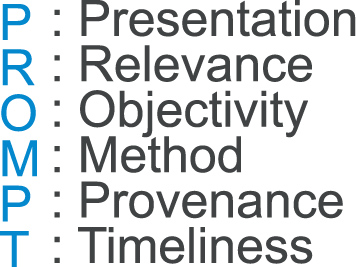When you’re searching for information for your essays, you’ll come across many sources on the Internet that you might consider using. So how do you sift out the good quality material from the less good? This article provides you with guidance on both a quick way to evaluate the quality of source material, and also how to carry out a more detailed evaluation of the information that you find, whether found on the Internet or through your learning institution’s Library resources.
Initial filtering
In my last article “Finding Source Materials for your Essays” I mentioned that the Internet (at time of writing) is an estimated 7.74 billion web pages in size, and of course content is added freely by billions of contributors. So whatever you search for, you’re probably going to get far more results than you actually want or need. So it’s important to weed out irrelevant information.
Your first line of fire is to review the title, summary, and any words highlighted in the text. For journal articles, peer review can provide a guide to academic quality, but you should still carry out your own evaluation, to be sure the information meets your needs.
Quick evaluation
A fast way to judge the quality and relevance of the information you find on the Internet is to ask yourself three simple questions: Who? Why? When? This one’s really easy to remember! So what does that mean?
- Who – ask yourself / try to find out who put the information there (who owns the website you found it on)? What authority or expertise do they have in this area?
- Why – ask yourself why they created the site? Do the stated aims of the site match the content? Is the creator of the site coming from a particular viewpoint? For example, many pressure groups present a rather biased version of the truth on a particular topic. Their sites may contain a wealth of information but it’s important to try and form a balanced opinion based on their views and those of others.
- When – how up to date is the website and when was it last updated? If the site has not been updated for a while, how important is this for your needs? For example, if you’re studying history, it may not be that important – but current affairs, more so!
Carrying out this quick easy-to-remember check should enable you to spot any obvious weaknesses in the information you are looking at, and filter out unreliable sources.
Evaluating in more depth
 The mnemonic PROMPT will help you remember the following checklist which can be used to assess the relevance of information you find.
The mnemonic PROMPT will help you remember the following checklist which can be used to assess the relevance of information you find.
P = Presentation
Is the information that you found clearly communicated? Consider the language, layout, structure, etc.
R = Relevance
Does the information that you found match your needs right now? Look at the introduction or overview – what is it mainly about?
O = Objectivity
Is the author’s position of interest made clear? Look for an introduction or overview – do the writers state their position on the issue? Is the language emotive? Are there hidden, vested interests? Note what I said above about pressure groups – always try to reach a balanced opinion based on what you find and also the views of other sites with a differing position on the issue.
M = Method (for research reports only)
Is it clear how the data was collected? Were the methods appropriate? Do you trust it?
P = Provenance
Is it clear where the information has come from? Can you identify the authors or organisations? How was it published? Sometimes you can’t find credible sources for a particular fact – in such cases, you might want to mention the issue in your essay and comment on the credibility of what you’ve found.
T = Timeliness
Is it clear when the information was produced? Does the date of the information meet your requirements? Is it obsolete? This will be more important for some topics than others!
Adapted from: Evaluate Information, The Open University, https://www8.open.ac.uk/library/help-and-support/using-resources/evaluate-information
Always use the Who? Why? When? and PROMPT techniques to filter your information and ensure that the material you use is credible and trustworthy. Don’t forget to scan your finished essay through plagiarismchecker.net Plagiarism Checker to ensure that you haven’t accidentally included other peoples’ words without giving due credit!

